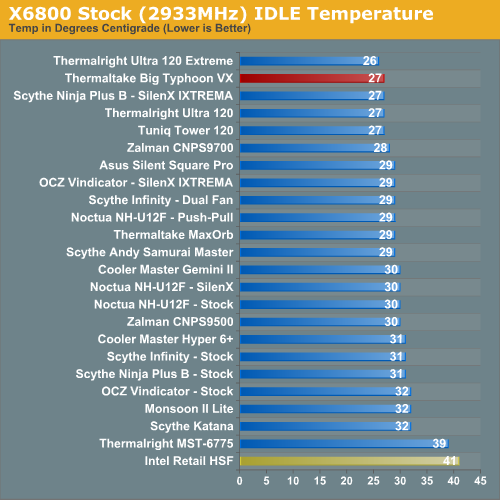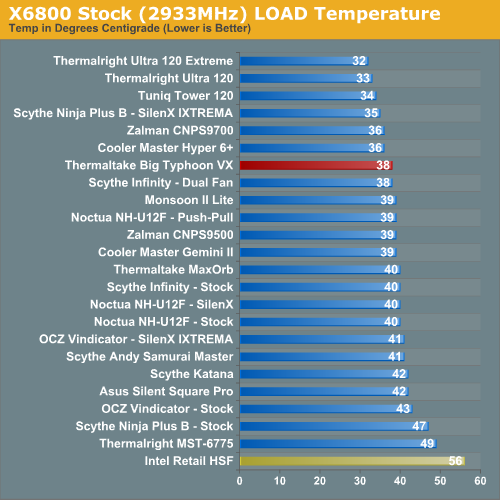Thermaltake Big Typhoon VX: Does VX Rule Cooling?
by Wesley Fink on June 7, 2007 5:10 AM EST- Posted in
- Cases/Cooling/PSUs
Cooling at Stock Speed
Some users will never overclock their CPU, but they still want to run the coolest CPU temperatures possible to enhance stability and extend CPU life. The Thermaltake Big Typhoon VX comes complete with a variable-speed high-output fan. Therefore we tested the VX cooler with the supplied fan at its maximum speed for the performance results.

Where the very good Intel stock cooler keeps the X6800 at 41C at idle, the VX managed 27C, which is outstanding performance. This is a significant improvement over the Intel stock cooler performance, and results are just 1C short of the best we have tested. The Thermalright coolers, at the top of our heatpipe tower performance charts, cool to 26C and 27C, and the Tuniq 120 maintains 27C. The Big Typhoon VX is very competitive in cooling at stock speed idle.
It is more difficult to effectively simulate a computer being stressed by all of the conditions it might be exposed to in different operating environments. For most home users CPU power is most taxed with contemporary gaming. Therefore our stress test simulates running a demanding contemporary game. The Far Cry River demo is looped for 30 minutes and the CPU temperature is captured at 4 second intervals with the NVIDIA monitor "logging" option. The highest temperature during the load test is then reported. Momentary spikes are ignored, as we report a sustained high-level temp that you would expect to find in this recording configuration. This test configuration roughly equates to an 80% CPU load test using Intel TAT.
Cooling efficiency of the Thermaltake Big Typhoon VX was then compared under load conditions at stock speed to the retail HSF and other recently tested CPU coolers.

The VX under load at stock speeds reached a maximum temperature of 38C with the included fan at its highest speed. This compares to the Thermalright coolers at 32C and 33C, the Tuniq at 34C and the Cooler Master Hyper 6+ and Zalman 9700 at 36C. Stock load performance is average to above average among tested coolers, which was something of a disappointment after the excellent stock idle results.
Some users will never overclock their CPU, but they still want to run the coolest CPU temperatures possible to enhance stability and extend CPU life. The Thermaltake Big Typhoon VX comes complete with a variable-speed high-output fan. Therefore we tested the VX cooler with the supplied fan at its maximum speed for the performance results.

Where the very good Intel stock cooler keeps the X6800 at 41C at idle, the VX managed 27C, which is outstanding performance. This is a significant improvement over the Intel stock cooler performance, and results are just 1C short of the best we have tested. The Thermalright coolers, at the top of our heatpipe tower performance charts, cool to 26C and 27C, and the Tuniq 120 maintains 27C. The Big Typhoon VX is very competitive in cooling at stock speed idle.
It is more difficult to effectively simulate a computer being stressed by all of the conditions it might be exposed to in different operating environments. For most home users CPU power is most taxed with contemporary gaming. Therefore our stress test simulates running a demanding contemporary game. The Far Cry River demo is looped for 30 minutes and the CPU temperature is captured at 4 second intervals with the NVIDIA monitor "logging" option. The highest temperature during the load test is then reported. Momentary spikes are ignored, as we report a sustained high-level temp that you would expect to find in this recording configuration. This test configuration roughly equates to an 80% CPU load test using Intel TAT.
Cooling efficiency of the Thermaltake Big Typhoon VX was then compared under load conditions at stock speed to the retail HSF and other recently tested CPU coolers.

The VX under load at stock speeds reached a maximum temperature of 38C with the included fan at its highest speed. This compares to the Thermalright coolers at 32C and 33C, the Tuniq at 34C and the Cooler Master Hyper 6+ and Zalman 9700 at 36C. Stock load performance is average to above average among tested coolers, which was something of a disappointment after the excellent stock idle results.










34 Comments
View All Comments
Xajel - Thursday, June 7, 2007 - link
AnandTech never reviewed the BT VX before, and when it did, it had concluded that this cooler is bad, why just coz another type of coolers are better !!the problem with this review is that the Cooler is very good, but the conclution did not give it what it deserve. it just said that a 90 degree mounted fans coolers are better.. ok I agree and thanks for AT for this, infact I just knows that thanks to Anand, but the problem is where the conclution for the VX as a cooler not as heatpipes tower vs. downfacing fans coolers comparision..
Wesley Fink - Thursday, June 7, 2007 - link
We did NOT say the BT was a bad cooler. We talked about the performance being the best for this type of cooler and the good things about installation and design. Don't you think It would be unfair to say the VX topped our perfromance list when it didn't?In our conclusion we also said "There is no doubt the Big Typhoon VX is, along with the Cooler Master GeminII, the best of the down-facing cooler designs." and "While performance does not top our charts, there are still many things to like about the Thermaltake Big Typhoon VX. It is one of the easiest to mount coolers we have ever tested. While we do have concerns about two pounds being supported by Intel-style push clips, the installation itself is easy and does not require you to remove your motherboard. It is equally easy if you are mounting the VX on an AMD processor.
The attached fan speed control is also very useful on the Big Typhoon VX, particularly since it is attached to a very high-output fan capable of 86.5CFM at high speed."
I don't think this is saying the cooler is bad.
DrMrLordX - Thursday, June 7, 2007 - link
It isn't a bad cooler at all. However, there are some ways to make it perform well under its potential.First off, it needs a side air duct or side case fan blowing down onto it so it can breathe efficiently. Give it that, and it will be far less likely to cycle hot air through its fins at high operating temperatures.
Secondly, it does need a fairly strong exhaust fan.
The Big Typhoon (standard and VX) has put in impressive showings on open-air testbeds that showcase its potential strengths. In restricted air environments, you wind up with a cooler that can not efficiently pull cool air into the case or move hot air out of the case (the latter of which is a nice feature of a properly-positioned L-shaped cooler).
I managed to get good operation out of mine using a Centurion 5. All I did was pull the side air duct off (the VX is too big to be mounted with that thing still screwed on to the side of the case) and use the VX's included fan as an exhaust. Then I put a Silverstone FM-121 on the VX itself. It serves as the intake fan for the case, cooling everything but the HDDs, plus the HSF fan as well. The exhaust fan more or less takes care of everything else. It's a simple and cheap solution that cools very well. In contrast, an L-shaped cooler in a similar setup would have problems due to there being no strong or direct intake . . . it would essentially be pulling air from inside the case which would, ideally, pull cool air from outside the case through various vents, but for the most part, it would also be pulling in air heated by other system components.
All this might account for why the VX did so well at idle but so poorly at load.
strikeback03 - Friday, June 8, 2007 - link
My Tuniq on an E6600 in a Centurion 5 idles at 27-28*C and goes to 33-34 at load with ambient around 75*F and just the stock case fans (80mm at front blowing in over hard drives, 120mm at back blowing out). The Tuniq is set to ~1350RPM.